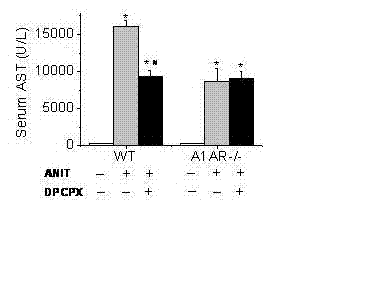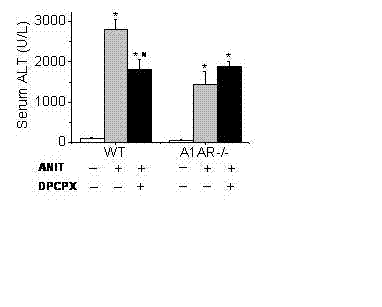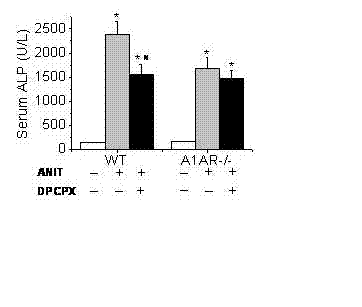Application of adenosine receptor A1 antagonist in preparing medicine
An adenosine receptor and antagonist technology, which is applied in the application field of preparing a drug for treating or preventing cholestatic liver disease, can solve the problems of failing to show the survival rate of ursodeoxycholic acid patients, and reduce the degree of necrosis of liver cells. , Enhance the ability of urinary excretion of bile acids and bilirubin, and prevent cholestatic liver disease
- Summary
- Abstract
- Description
- Claims
- Application Information
AI Technical Summary
Problems solved by technology
Method used
Image
Examples
Embodiment 1
[0142] adenosine receptor A 1 Effect of antagonist (DPCPX) on cholestatic liver injury.
[0143] 1. Establishment of animal models:
[0144] Experimental animals were C57BL / 6 (WT) mice and A 1 AR - / - mice. Raised under standard experimental conditions: 12-hour light-12-hour dark cycle, free access to water and food. ANIT is used to establish the model of drug-induced cholestasis liver disease, and it is administered by intragastric administration (75mg / kg). WT mice and A 1 AR - / - The mice were randomly divided into three groups. The first group was the control group (veh / veh), which was treated with the corresponding drug solvent during the experiment; the second group was the ANIT group (veh / ANIT), which was given the corresponding solvent of DPCPX and gavage ANIT; the third group is the DPCPX treatment group (DPCPX / ANIT), DPCPX (0.1mg / kg) is given by intraperitoneal injection 15 minutes before ANIT gavage, twice a day, once every 12 hours. After 48 hours of intragast...
Embodiment 2
[0153] adenosine receptor A 1 Effect of antagonist (DPCPX) on bile acid metabolism.
[0154] 1. Establishment of animal models:
[0155] The experimental animals were WT mice. Raised under standard experimental conditions: 12-hour light-12-hour dark cycle, free access to water and food. ANIT is used to establish the model of drug-induced cholestasis liver disease, and it is administered by intragastric administration (75mg / kg). WT mice were randomly divided into three groups. The first group was the control group (veh / veh), which was treated with the corresponding drug solvent during the experiment; the second group was the ANIT group (veh / ANIT), which was given the corresponding solvent of DPCPX and gavage ANIT; the third group is the DPCPX treatment group (DPCPX / ANIT), DPCPX (0.1mg / kg) is given by intraperitoneal injection 15 minutes before ANIT gavage, twice a day, once every 12 hours. After 48 hours of intragastric administration of ANIT, all mice in the experimental ...
Embodiment 3
[0164] other adenosine receptor A 1 Effect of antagonists on cholestatic liver injury.
PUM
 Login to View More
Login to View More Abstract
Description
Claims
Application Information
 Login to View More
Login to View More - R&D Engineer
- R&D Manager
- IP Professional
- Industry Leading Data Capabilities
- Powerful AI technology
- Patent DNA Extraction
Browse by: Latest US Patents, China's latest patents, Technical Efficacy Thesaurus, Application Domain, Technology Topic, Popular Technical Reports.
© 2024 PatSnap. All rights reserved.Legal|Privacy policy|Modern Slavery Act Transparency Statement|Sitemap|About US| Contact US: help@patsnap.com










